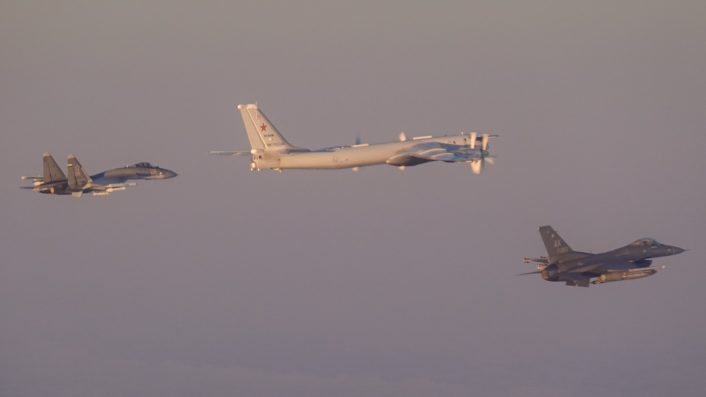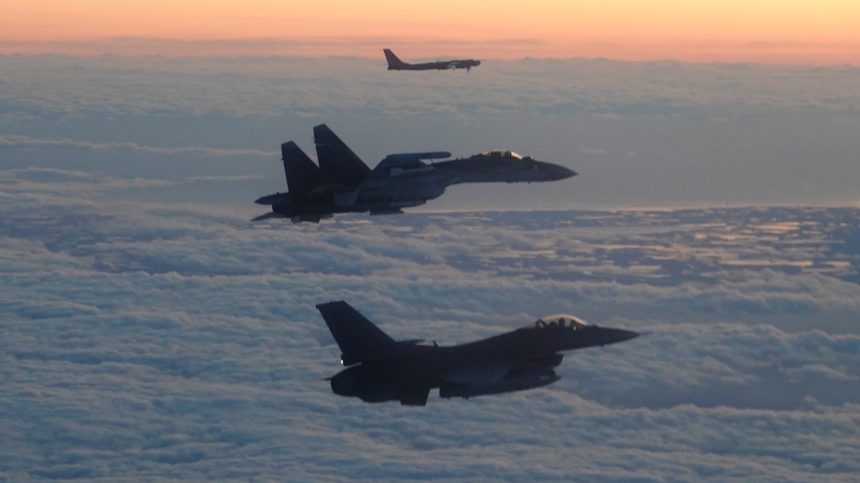Russian aircraft were intercepted over the Alaska ADIZ and the Baltic Sea hours after Trump suggested NATO should shoot down intruding jets.
Two formations of Russian aircraft have been intercepted few hours apart in the Alaska ADIZ (Air Defense Identification Zone) and over the Baltic Sea. The first, on Sept. 24, 2025, saw NORAD (North American Aerospace Defense Command) F-16s intercepting two Tu-95 Bear bombers and two Su-35 fighters, while the second, on Sept. 25, saw Hungarian Gripens intercepting three MiG-31s, one Su-35 and one Su-30.
Coincidentally, these intercepts happened shortly after U.S. President Donald Trump commented on Sept. 23 he believes Ukraine could be able to restore its borders from before the Russian invasion and suggested that NATO member countries should shoot down Russian aircraft intruding in their airspace. It is being reported that this might be the first time Trump suggested Ukraine could take back all of the territory lost to Russia, a significant shift from the previous suggestions about Ukraine giving up some of its territory in order to secure a peace deal.
Shooting Down Russian Aircraft
On the sidelines of the United Nations General Assembly in New York, Trump met Ukrainian President Volodymyr Zelenskyy. A reporter asked Trump “Do you think that NATO countries should shoot down Russian aircraft if they enter their airspace?” The reply was a quick “Yes, I do.”

Following this answer, the reporter asked a follow-on question whether the U.S. would back up NATO Allies if they shot down Russian aircraft, to which Trump responded “it depends on the circumstance.”
The suggestion about shooting down Russian aircraft was echoed by European leaders, as well as European Commission President Ursula von der Leyen, who said that this option is “on the table.” NATO Secretary General Mark Rutte however said any decision to shoot down Russian aircraft would depend on the specific threat level.
“My opinion is we have to defend every square centimeter of the territory,” von der Leyen said in an interview with CNN. “That means if there is an intrusion in the airspace, after warning, after being very clear, of course the option of shooting down a fighter jet that is intruding our airspace is on the table.”
Roger that. https://t.co/SPs85U7yPd
— Radosław Sikorski 🇵🇱🇪🇺 (@sikorskiradek) September 23, 2025
“Roger that,” wrote Polish Foreign Minister Radoslaw Sikorski responding to a video clip of Trump answering to the reporter. Poland recently saw a number of Russian drones entering its airspace, with some shot down.
Marko Mihkelson, chairman of the Estonian Parliament’s Foreign Affairs Committee, similarly responded to the same video clip writing “We got it.” Few days earlier, three MiG-31s entered Estonian airspace, remaining inside for about 12 minutes, and were intercepted by F-35As of the Italian Air Force currently deployed to Ämari Air Base, Estonia, to support NATO’s Baltic Air Policing mission.
Alaskan ADIZ Intercept
On Sept. 24, 2025, NORAD detected and tracked two Tu-95s and two Su-35s flying in the Alaska Air Defense Identification Zone. This prompted the scramble of four F-16s, supported by four KC-135 tankers and an E-3 AWACS.
The F-16s positively identified and intercepted the Russian formation over the Bering Sea, saying they remained in international airspace and did not enter American or Canadian sovereign airspace. The photos released the F-16s of the 18th Fighter Interceptor Squadron (FIS) out of Eielson Air Force Base, Alaska, flying off a Su-35’s wing, which is in turn flying off the Tu-95’s wing.
NORAD noted such Russian activity near Alaska occurs regularly and is not seen as a threat. However, this is already the ninth such intercept in the area and follows a stretch of four intercepts in a span of a week during August 2025.
These intercepts, which happened while the Northern Edge exercise was being held in the area, involved Il-20 “Coot” surveillance aircraft. Equipped with an array of antennas, sensors, and signals intelligence equipment, the Il-20 is designed to gather electronic and communications intelligence.
Baltic Sea Intercept
On Sept. 25, 2025, NATO scrambled two Gripens of the Hungarian Air Force, deployed to Šiauliai, Lithuania, as part of the Baltic Air Policing mission, to intercept a formation of Russian fighters flying close to Latvia’s airspace. The formation included three MiG-31s, a Su-30 and a Su-35.
The Allied Air Command (AIRCOM) said the five-ship formation was flying close to NATO airspace, without complying with international flight safety regulations. Although it was not specified on this occasion, this phrasing is often accompanied by the mention of the absence of a filed flight plan and the lack of radio contacts with air traffic controllers, as well as the transponders being turned off.
NATO further said the fighters were identified west of the Latvian coast before being escorted. No details were provided about the route the aircraft were flying or additional assets launched in support of the Gripens. An Italian E-550 CAEW (Conformal Airborne Early Warning) was flying on Sept. 24, although without knowing the time of the intercept it is not possible to confirm whether it supported the Gripens.









